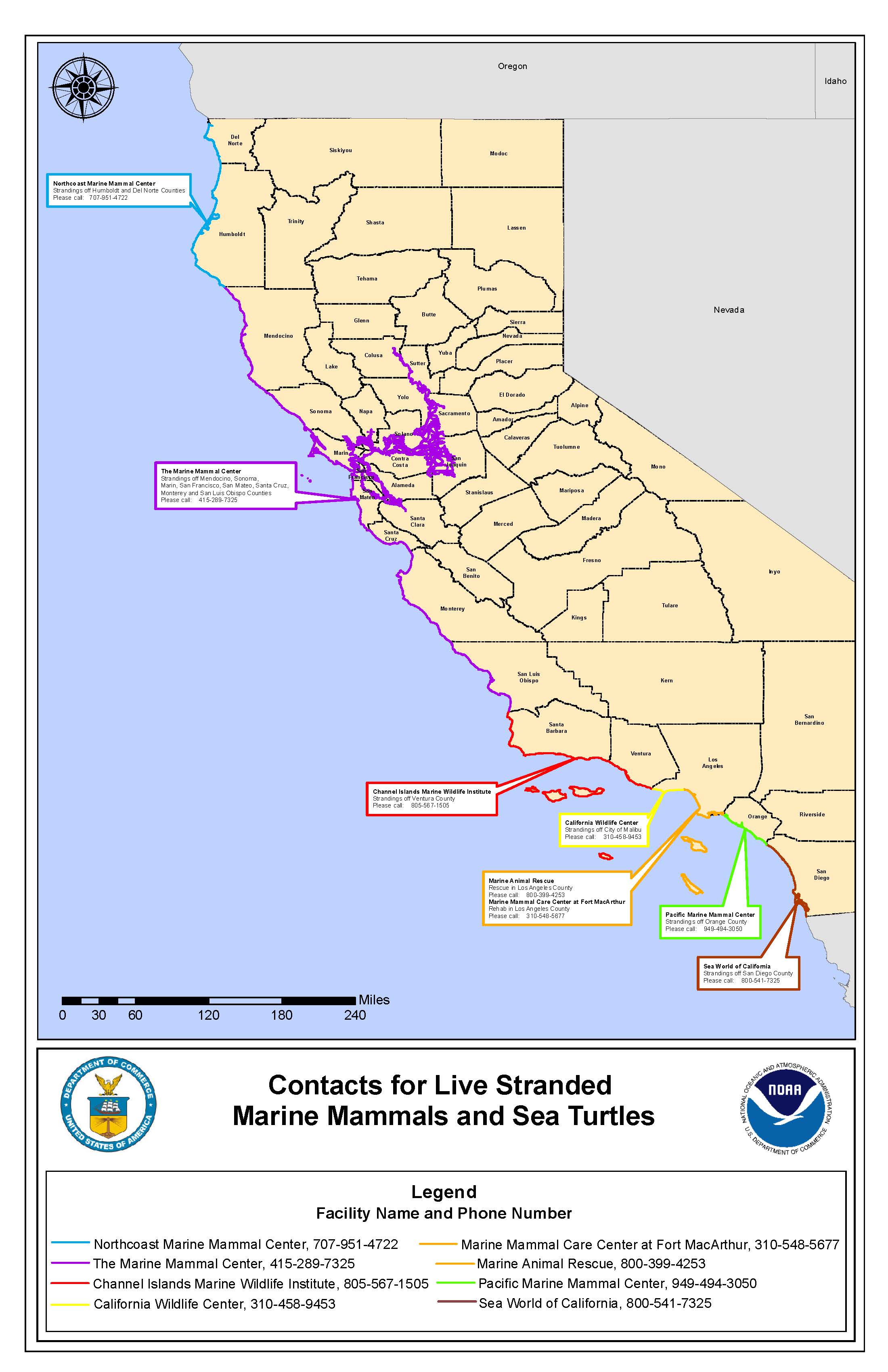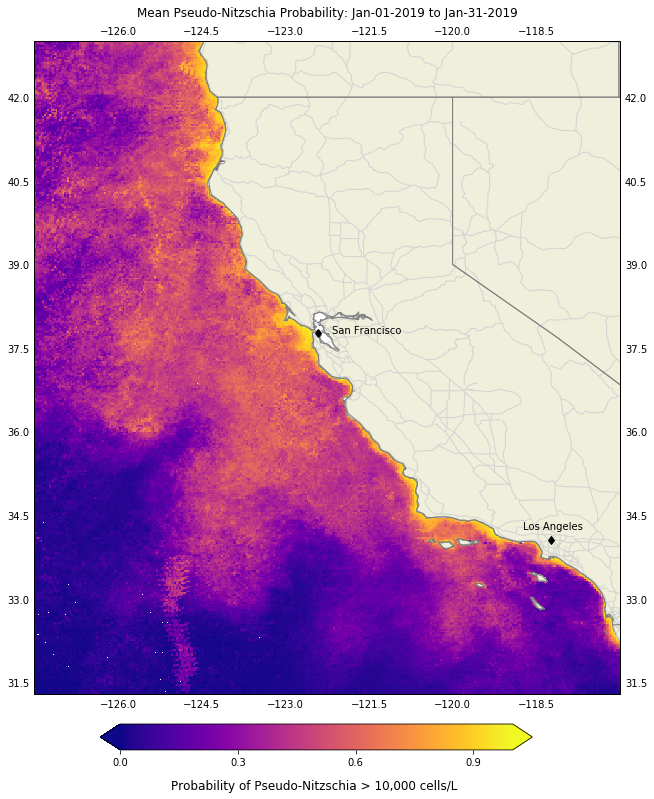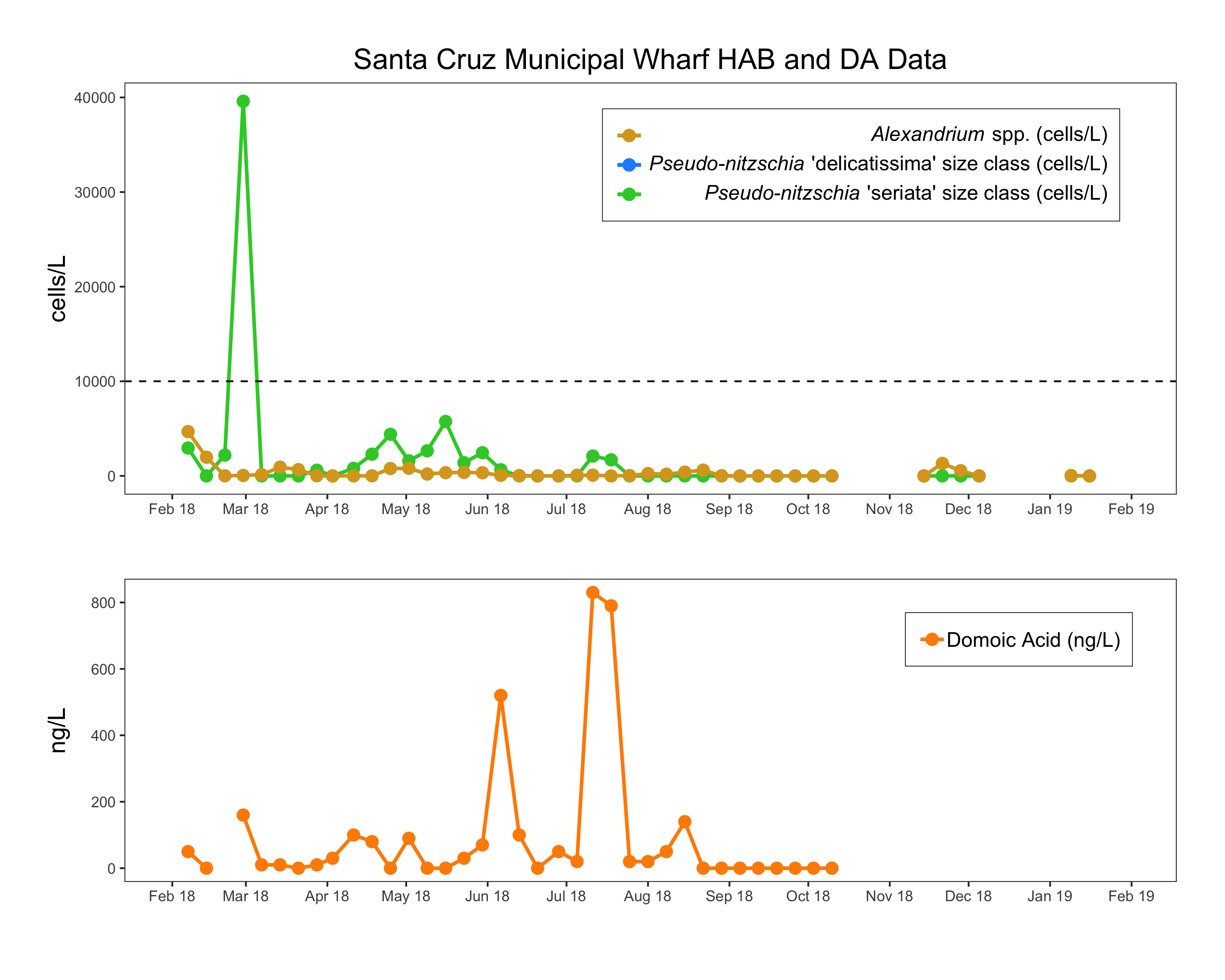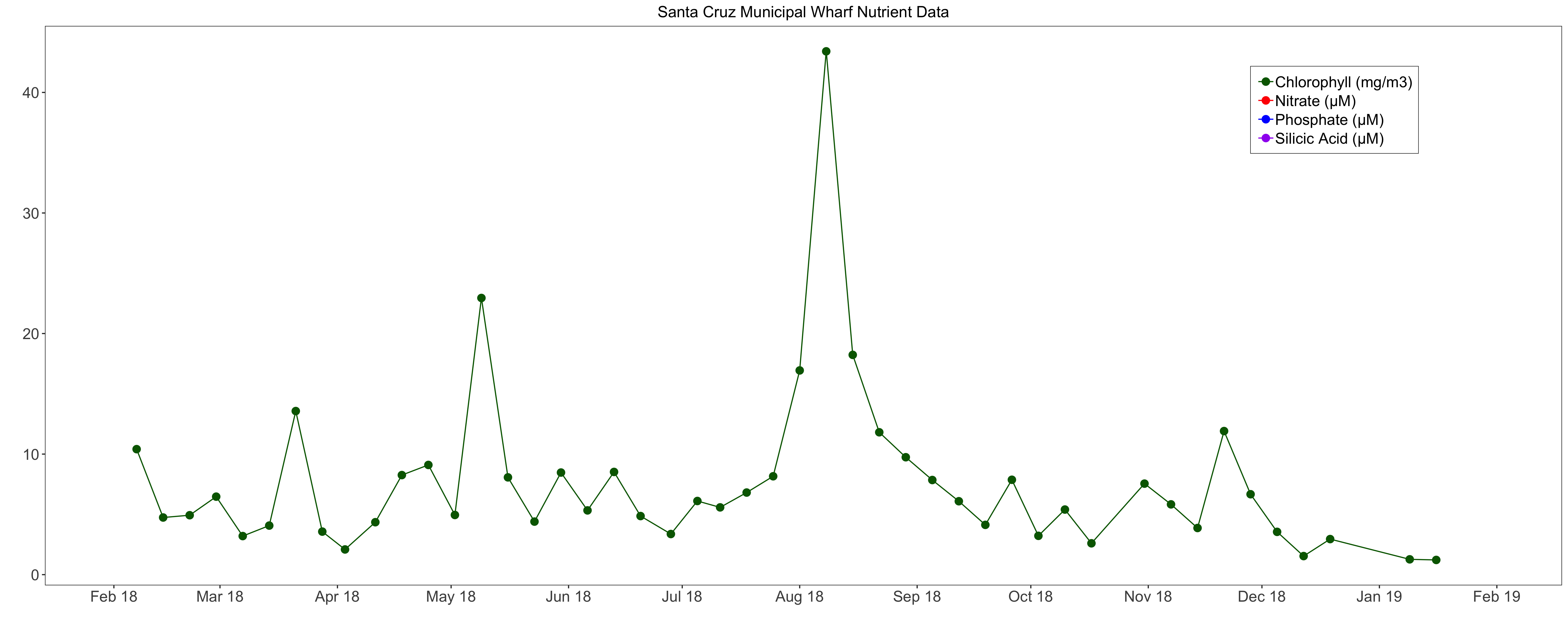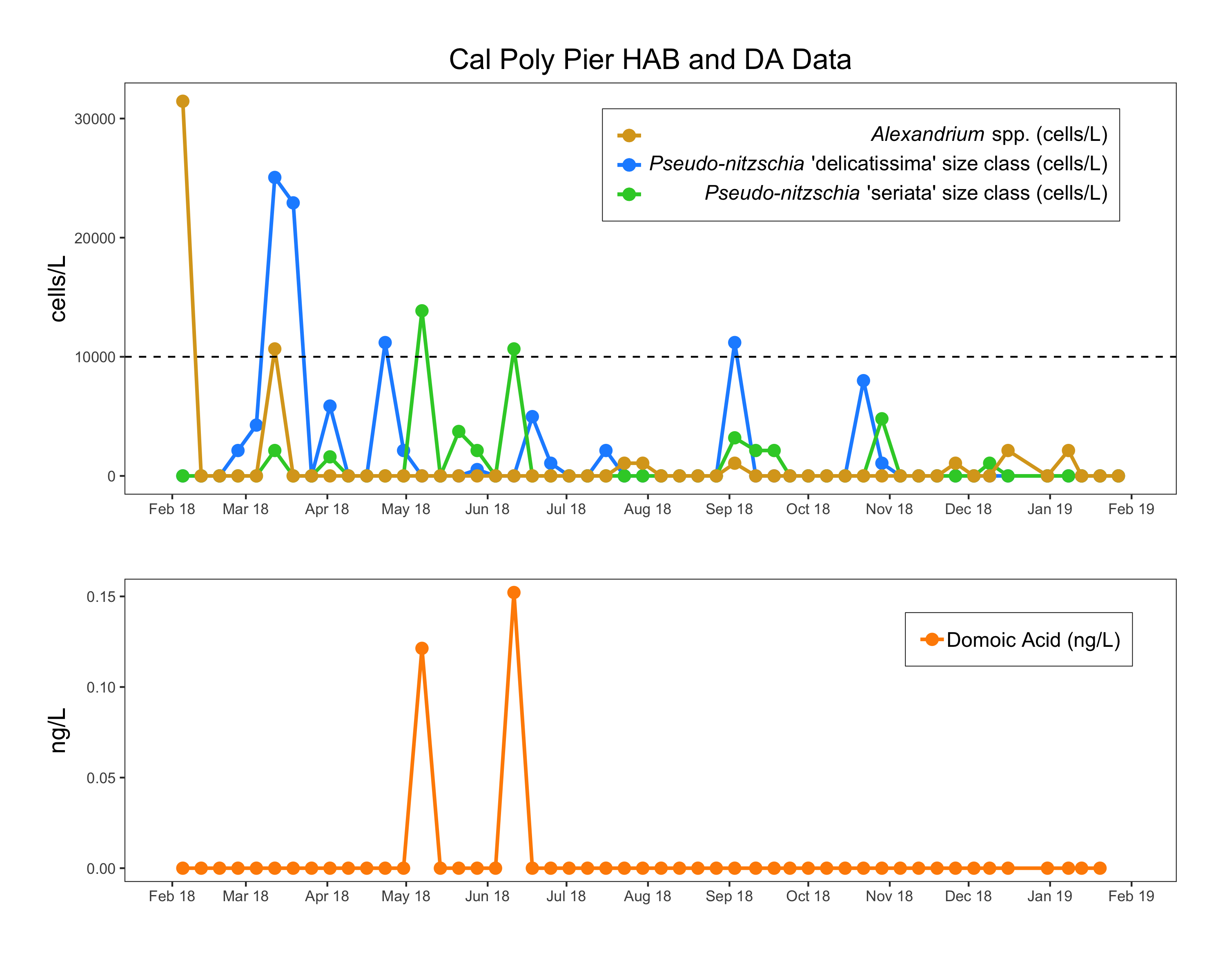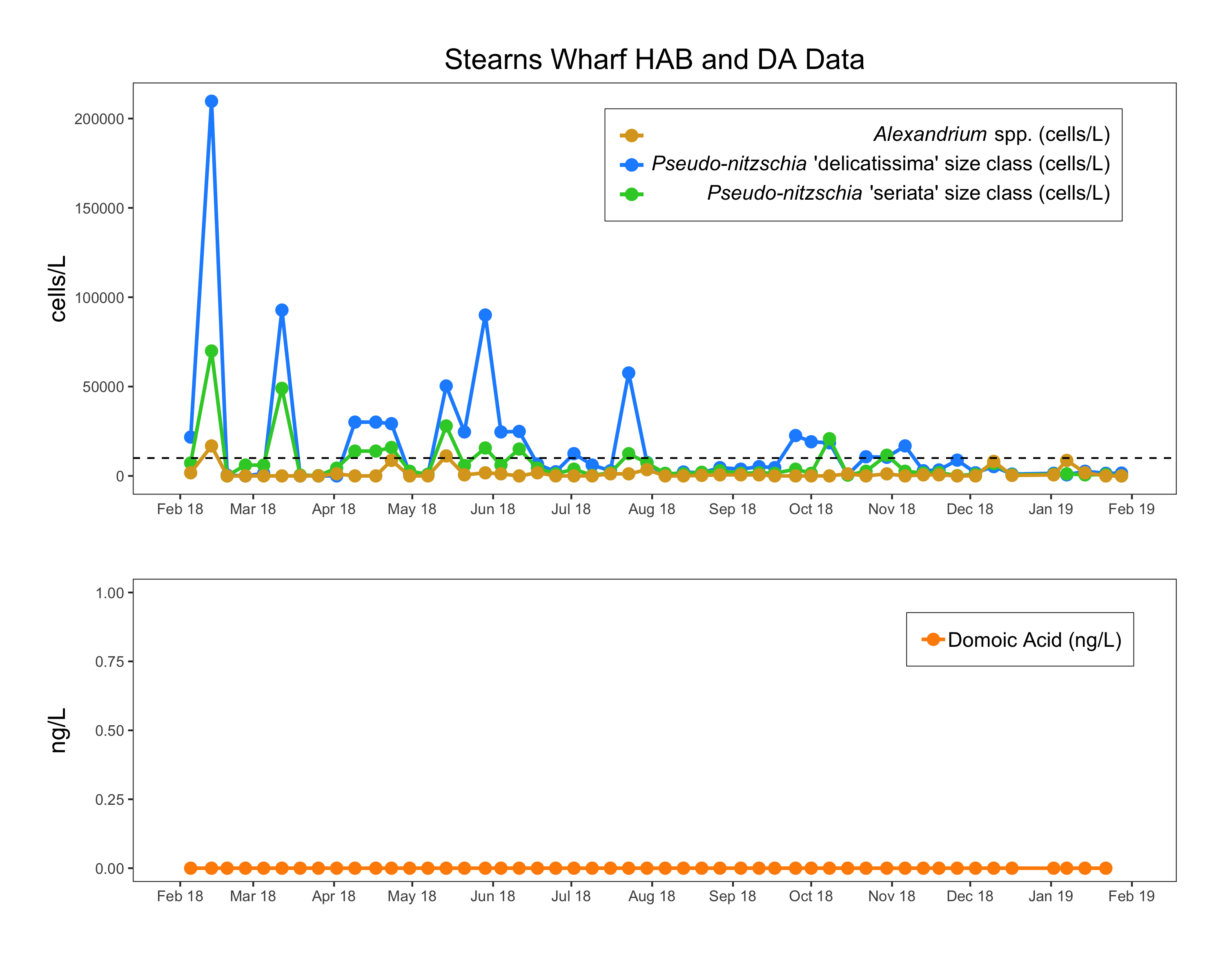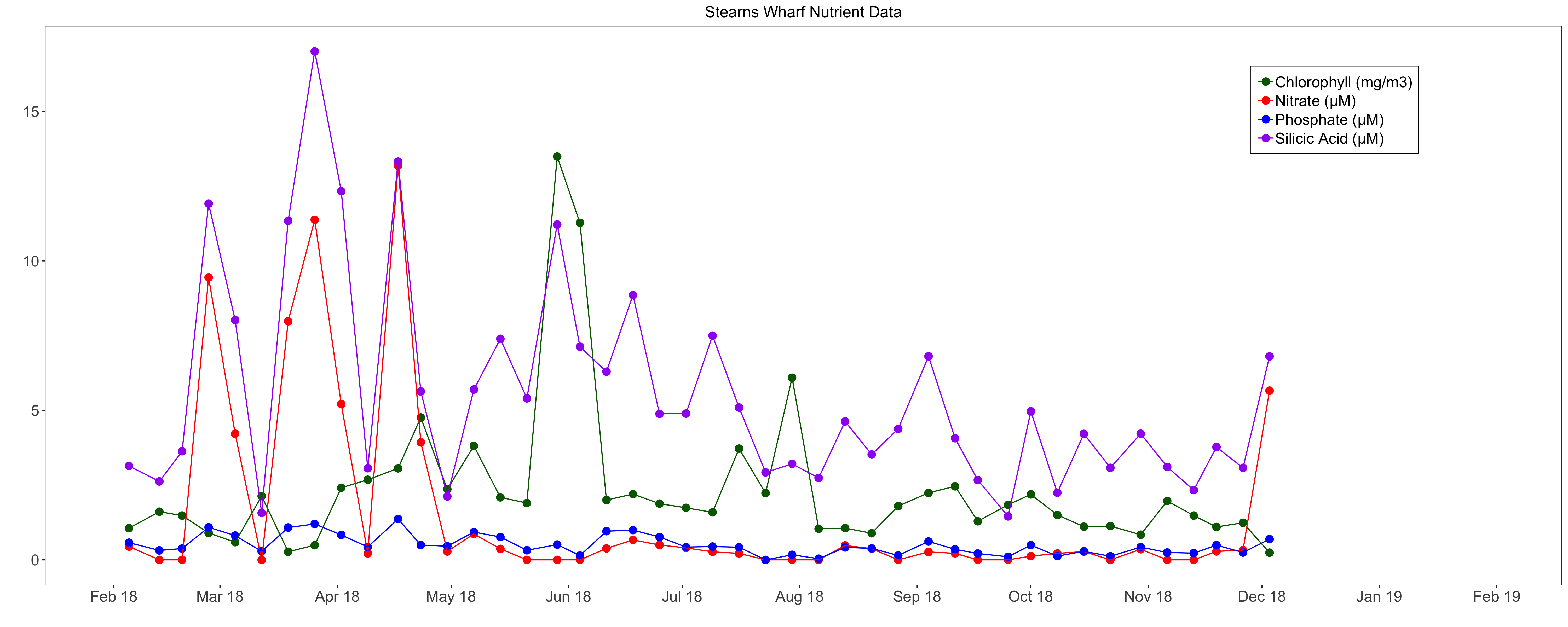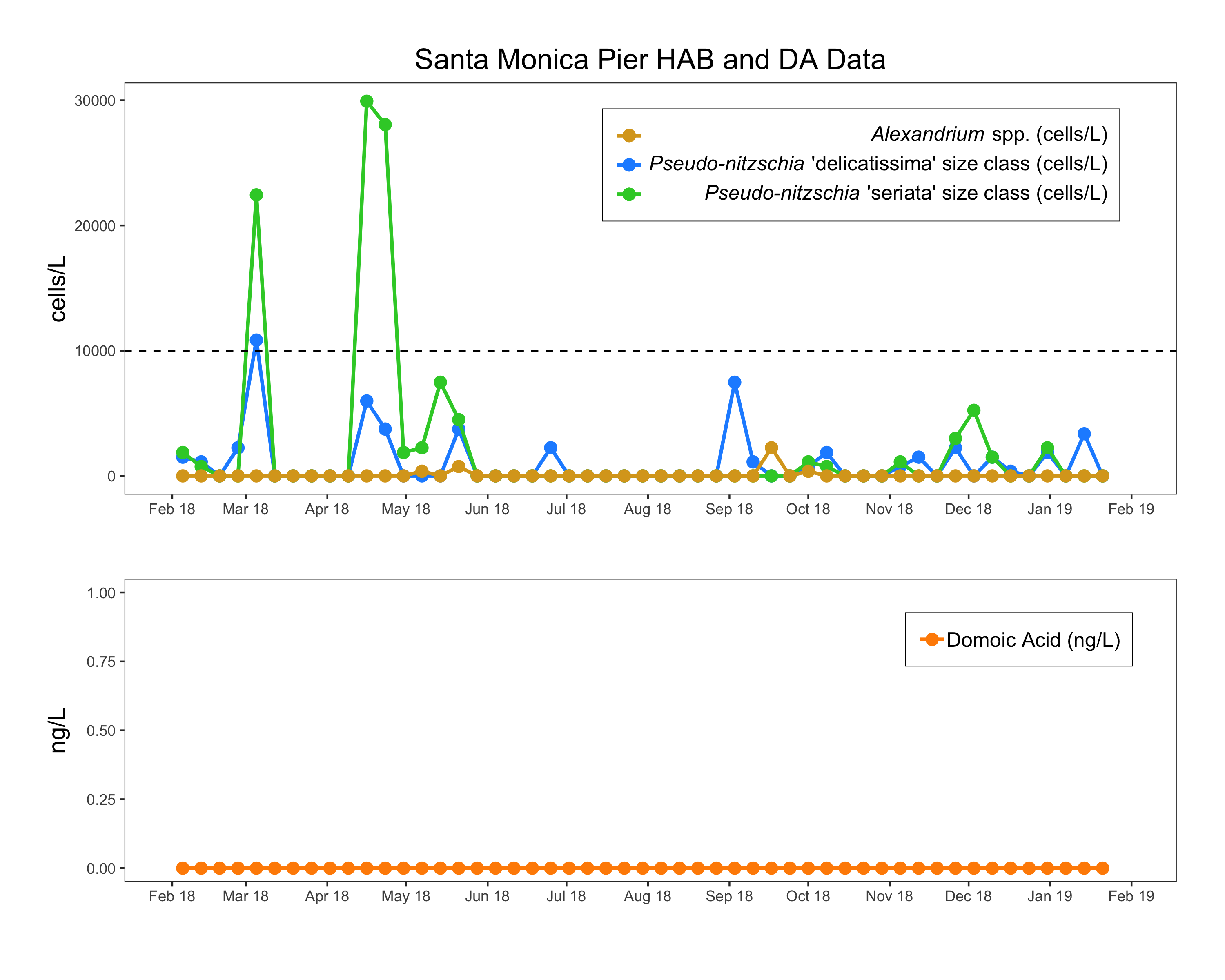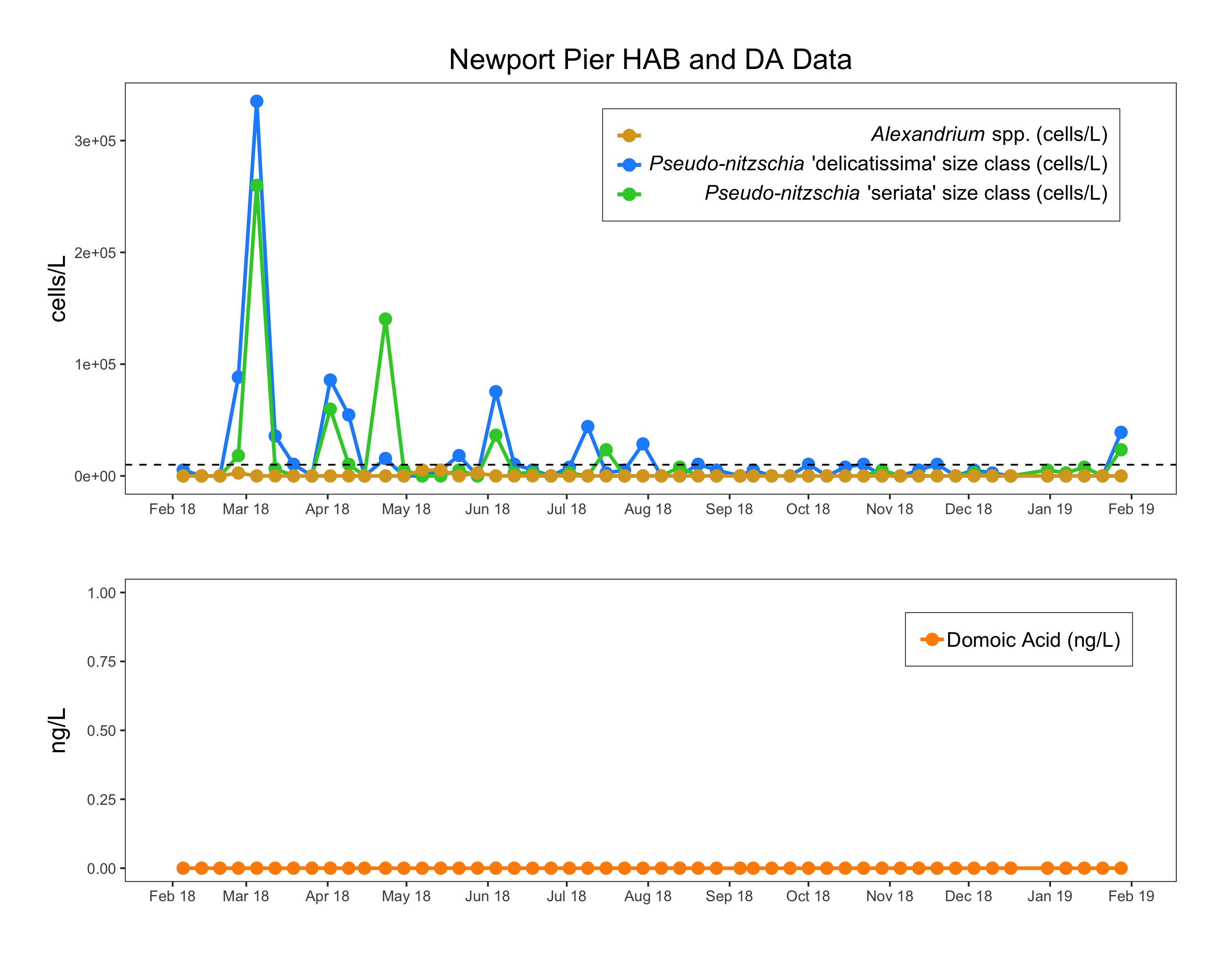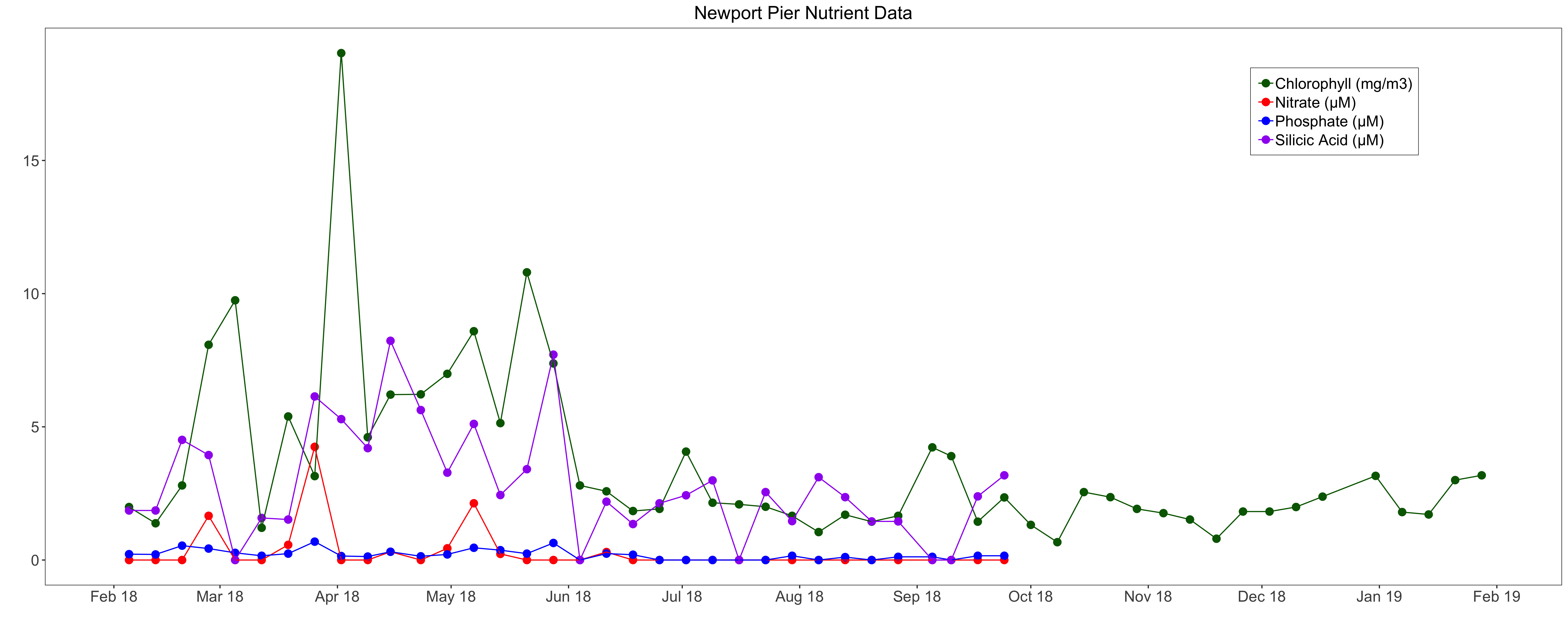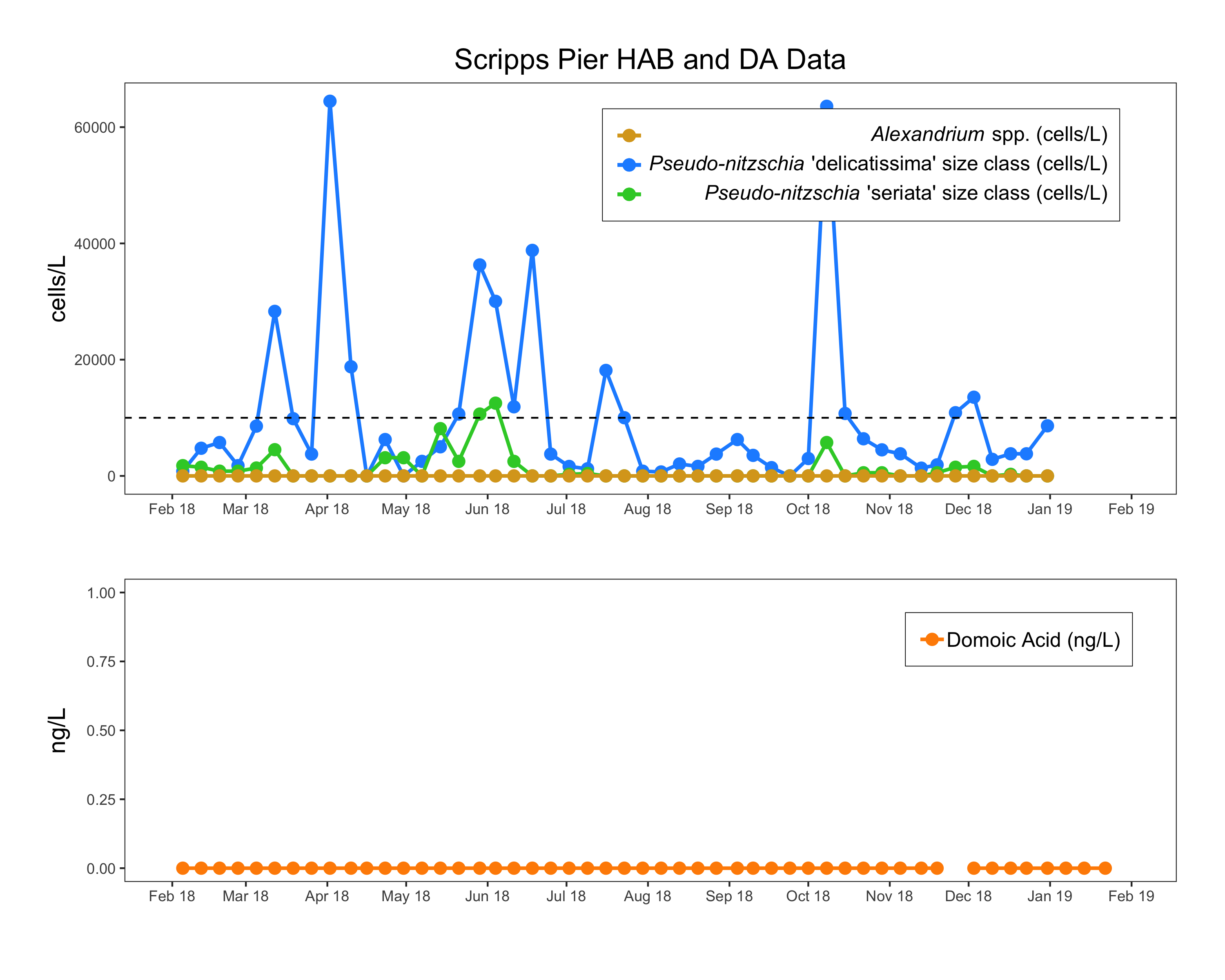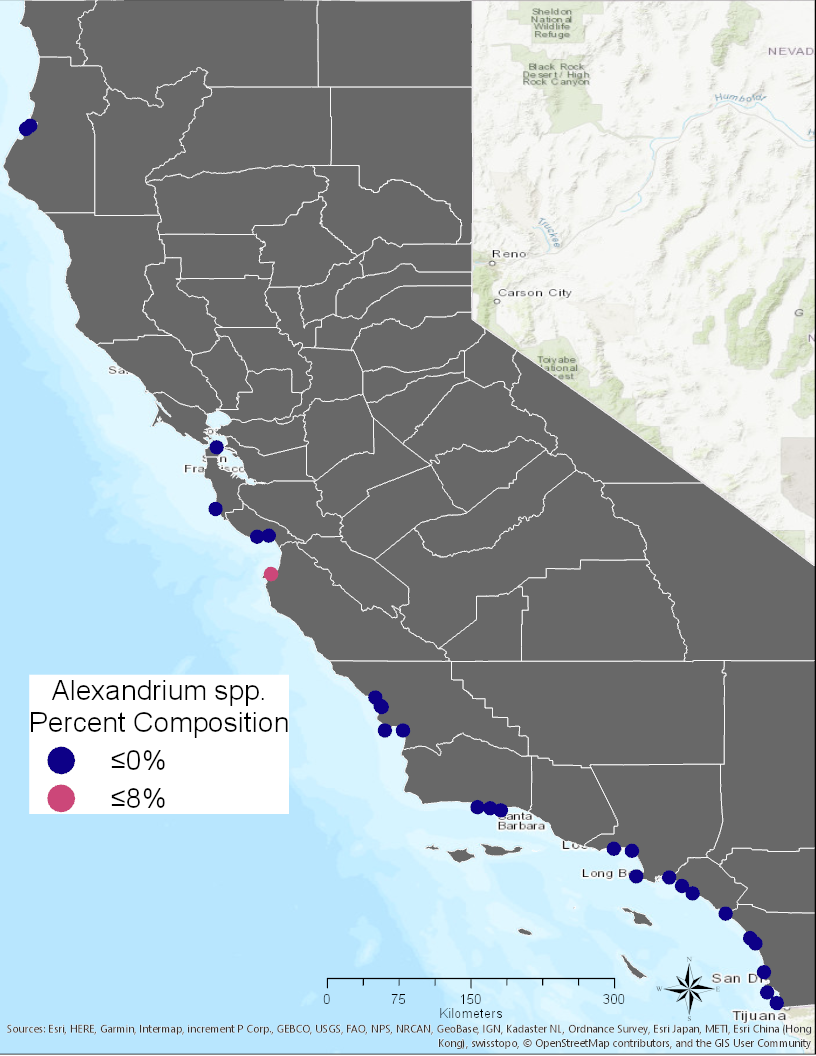Pseudo-nitzschia - C-HARM tells us where conditions are suitable for Pseudo-nitzschia spp. (all size classes) to grow well and where they might be more likely to produce domoic acid (DA). The January mean of Pseudo-nitzschia bloom predictions suggests that the likelihood of bloom levels was high in a narrow band along the entire coast, with more variable high-probability patches in the offshore environment. There is a chance that heavy storm activity is leading to heavy runoff in the nearshore zone and the model is misinterpreting this as Pseudo-nitzschia due to the difficulty differentiating different types of reflectance when river discharge/plumes are pronounced. However, the high probabilities are still consistent with January HABMAP records at Newport Beach Pier and Santa Monica Pier, particularly at Newport Beach Pier where the ‘seriata’ and ‘delicatissima’ size classes both exceeded the bloom threshold towards the end of January, coincident with an uptick in chlorophyll concentrations. Stearns Wharf did not experience this rise in Pseudo-nitzschia abundance in January. HABMAP data for Scripps Pier were temporarily unavailable, but in general, this pattern is consistent with the HABMAP time series record that shows that the larger and more toxigenic ‘seriata’ size class tends to become more represented in the community in late fall to winter months (Nov-Jan). Consistent with the HABMAP data, CDPH samples show elevated Pseudo-nitzschia spp. relative abundance at many sites in Southern California and one site in central CA near San Luis Obispo where HABMAP data have not yet been uploaded in order to establish a pattern.
Domoic Acid - C-HARM also tells us where DA might be more likely. As in December, probabilities are high in the month of January in the very coastal region of the North Coast, near the mouth of San Francisco Bay, and offshore for most of the central CA coast and throughout the Southern California Bight. The offshore extent of high pDA probabilities in the Bight has been counter to the low prediction of positive Pseudo-nitzschia growth in those offshore pixels. Interestingly, cellular DA (cDA) probabilities are very low along the North Coast were particulate DA probabilities were high, suggesting that high biomass along that narrow band could be responding to pulses of new nutrients in surface waters and not expressing very high cDA production rates yet. This inversion occurs at several points along the coastline and could be tied to upwelling pulses or storm-induced mixing events. Probabilities of high cDA are elevated in Monterey Bay, central CA coast, Santa Barbara Channel, and parts of the Bight. The high pDA probabilities in the nearshore zone of northern California are supported by the delayed opening of the commercial Dungeness crab fishery (from Patrick’s Pt. to the CA-OR border due to unsafe levels of DA), which was re-opened for parts of Humboldt Co. on Jan 15 but remained closed for Crescent City for much of the month. The recreational Dungeness crab fishery was also closed, but by the end of January, both commercial and recreational fisheries were open statewide. HABMAP observations for January are currently limited to Stearns Wharf, Santa Monica Pier, and Newport Beach Pier where they were all zeros. All marine mammal strandings from DA for the month of January were limited to central CA in the San Luis Obispo and Monterey Counties. CDPH has the only observations currently recorded for that region with elevated Pseudo-nitzschia relative abundance, and the pattern is consistent with high pDA and cDA probabilities in the central offshore region from C-HARM (although keep in mind, they were also predicted to be high elsewhere, such as the Bight where no DA cases were reported for January).
Alexandrium - HABMAP records for Alexandrium indicate virtually no activity, although very low abundances were seen at Stearns Wharf in early January. CDPH saw elevated relative abundance near Monterey, but no health advisories for Paralytic Shellfish Poisoning (PSP) were reported.
C-HARM Model
HABMAP Observations
HABMAP Monitoring Sites
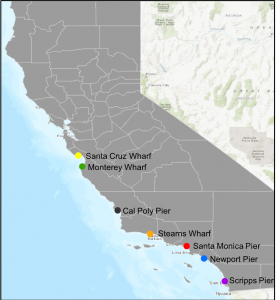
Note that data for some stations are not shown because they are not yet recorded in the public HABMAP archive.
Differentiating Pseudo-nitzschia species by light microscopy is difficult. For this reason, Pseudo-nitzschia "seriata" does not refer to an actual species but rather the larger size class of Pseudo-nitzschia, which is generally a more toxigenic group of species. Alternatively, Pseudo-nitzschia "delicatissima" refers to the smaller size class that is generally non-toxigenic. The dashed line on the plots demarcates the 10,000 cells/L "bloom" threshold designated here for Pseudo-nitzschia populations only.
Santa Cruz Municipal Wharf
Cal Poly Pier
Stearns Wharf
Santa Monica Pier
Newport Beach Pier
Scripps Pier
>CDPH observations for Pseudo-nitzschia spp. and Alexandrium spp.
From 1-31 January 2019, water samples were collected by volunteers and sent to the California Department of Public Health (CDPH) for analysis. Pseudo-nitzschia spp. were detected in 37 of the 93 samples. Percent composition of Pseudo-nitzschia spp. was greatest on January 25th at Bolsa Chica (10% composition) and on January 4th at Long Beach (9% composition). Alexandrium spp. were detected in 4 of the 38 samples. Percent composition was greatest in southern Monterey Bay on January 4th (8% composition); Alexandrium were detected in low levels (<0.5% composition) on Jan 9th, 19th, and 25th. You can also view CDPH weekly map layers of Pseudo-nitzschia and Alexandrium here.
On January 18th, the California Department of Fish and Wildlife (CDFW) issued a declaration to open recreational and commercial Dungeness crab fisheries from Patrick's Point, Humboldt County north to the California/Oregon state line. The health advisory has been lifted for both recreational and commercial Dungeness crab fisheries statewide. Throughout November and December, delays in the commercial Dungeness crab fishery opener occurred, first due to meat quality, and later in December, due to high DA.
For the latest closures and updates, please visit the CDFW Health Advisories page. Data are provided by the California Department of Public Health, Environmental Management Branch.
California Sea Lion Strandings from DA Toxicosis
Domoic acid (DA) is a potent neurotoxin produced by some diatom species of the genus Pseudo-nitzschia. Species exposed to DA can result in seizures, epilepsy, cardiomyopathy, and death depending upon the ingested dose. DA toxicosis commonly occurs in California Sea Lions (Zalophus Californianus), presumably due to a combination of foraging behavior and seasonal movements. The Marine Mammal Center, the Marine Mammal Care Center Los Angeles, the Pacific Marine Mammal Center, and SeaWorld act like an emergency room by working to rescue and rehabilitate sick and injured marine mammals, seabirds, and sea turtles.
In 2018 The Marine Mammal Center documented a total of 93 sea lion strandings with symptoms of domoic acid toxicosis.
6 sea lion strandings presented with symptoms of domoic acid toxicosis in the month of January by The Marine Mammal Center (TMMC).
No DA toxicosis cases have been reported by the Pacific Marine Mammal Center, the Marine Mammal Care Center Los Angeles or SeaWorld in January 2019.
January sea lion strandings due to DA toxicosis occurred at the following locations:
- January 4th, 2019 - Morro Strand State Beach, Morro Bay, San Luis Obispo County
- January 6th, 2019 - Green Gables Inn, Pacific Grove, Monterey County
- January 15th, 2019 - Pismo State Beach, Pismo Beach, San Luis Obispo County
- January 15th, 2019 - Cayucos State Beach, Cayucos, San Luis Obispo County
- January 18th, 2019 - Del Monte Beach, Dal City, Monterey County
- January 26th, 2019 - Sawmill, Pebble Beach, Monterey County
Who to call if you find a LIVE stranded marine mammal or sea turtle
Sea World of California (800) 541-7325
- San Diego County
Pacific Marine Mammal Center (949) 494-3050
- Orange County
Marine Animal Rescue (800) 399-4253 and California Wildlife Center (310) 458-9453
- Los Angeles County
Channel Islands Marine Wildlife Institute (805) 567-1505
- Santa Barbara County
- Ventura County
The Marine Mammal Center (415) 289-7325
- Alameda County
- Contra Costa County
- Marin County
- Mendocino County
- Monterey County
- Napa County
- Sacramento County
- San Francisco County
- San Luis Obispo
- San Mateo County
- Santa Cruz County
- Sonoma County
Northcoast Marine Mammal Center (707) 951-4722
- Del Norte County
- Humboldt County
